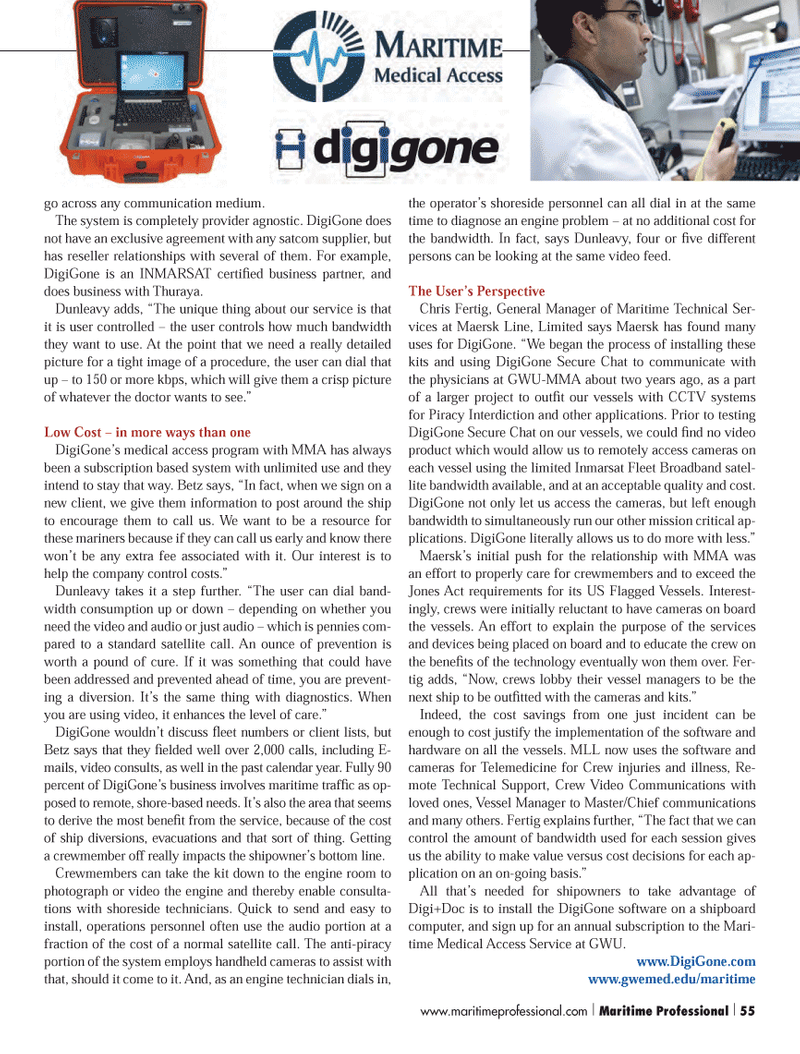
Page 55: of Maritime Logistics Professional Magazine (Q3 2013)
Training & Security
Read this page in Pdf, Flash or Html5 edition of Q3 2013 Maritime Logistics Professional Magazine
go across any communication medium. The system is completely provider agnostic. DigiGone does not have an exclusive agreement with any satcom supplier, but has reseller relationships with several of them. For example, DigiGone is an INMARSAT certiÞ ed business partner, and does business with Thuraya. Dunleavy adds, ÒThe unique thing about our service is that it is user controlled Ð the user controls how much bandwidth they want to use. At the point that we need a really detailed picture for a tight image of a procedure, the user can dial that up Ð to 150 or more kbps, which will give them a crisp picture of whatever the doctor wants to see.Ó Low Cost ? in more ways than one DigiGoneÕs medical access program with MMA has always been a subscription based system with unlimited use and they intend to stay that way. Betz says, ÒIn fact, when we sign on a new client, we give them information to post around the ship to encourage them to call us. We want to be a resource for these mariners because if they can call us early and know there wonÕt be any extra fee associated with it. Our interest is to help the company control costs.Ó Dunleavy takes it a step further. ÒThe user can dial band- width consumption up or down Ð depending on whether you need the video and audio or just audio Ð which is pennies com-pared to a standard satellite call. An ounce of prevention is worth a pound of cure. If it was something that could have been addressed and prevented ahead of time, you are prevent- ing a diversion. ItÕs the same thing with diagnostics. When you are using video, it enhances the level of care.Ó DigiGone wouldnÕt discuss ß eet numbers or client lists, but Betz says that they Þ elded well over 2,000 calls, including E- mails, video consults, as well in the past calendar year. Fully 90 percent of DigiGoneÕs business involves maritime trafÞ c as op- posed to remote, shore-based needs. ItÕs also the area that seems to derive the most beneÞ t from the service, because of the cost of ship diversions, evacuations and that sort of thing. Getting a crewmember off really impacts the shipownerÕs bottom line. Crewmembers can take the kit down to the engine room to photograph or video the engine and thereby enable consulta-tions with shoreside technicians. Quick to send and easy to install, operations personnel often use the audio portion at a fraction of the cost of a normal satellite call. The anti-piracy portion of the system employs handheld cameras to assist with that, should it come to it. And, as an engine technician dials in, the operatorÕs shoreside personnel can all dial in at the same time to diagnose an engine problem Ð at no additional cost for the bandwidth. In fact, says Dunleavy, four or Þ ve different persons can be looking at the same video feed.The User?s Perspective Chris Fertig, General Manager of Maritime Technical Ser- vices at Maersk Line, Limited says Maersk has found many uses for DigiGone. ÒWe began the process of installing these kits and using DigiGone Secure Chat to communicate with the physicians at GWU-MMA about two years ago, as a part of a larger project to outÞ t our vessels with CCTV systems for Piracy Interdiction and other applications. Prior to testing DigiGone Secure Chat on our vessels, we could Þ nd no video product which would allow us to remotely access cameras on each vessel using the limited Inmarsat Fleet Broadband satel- lite bandwidth available, and at an acceptable quality and cost. DigiGone not only let us access the cameras, but left enough bandwidth to simultaneously run our other mission critical ap-plications. DigiGone literally allows us to do more with less.Ó MaerskÕs initial push for the relationship with MMA was an effort to properly care for crewmembers and to exceed the Jones Act requirements for its US Flagged Vessels. Interest- ingly, crews were initially reluctant to have cameras on board the vessels. An effort to explain the purpose of the services and devices being placed on board and to educate the crew on the beneÞ ts of the technology eventually won them over. Fer- tig adds, ÒNow, crews lobby their vessel managers to be the next ship to be outÞ tted with the cameras and kits.Ó Indeed, the cost savings from one just incident can be enough to cost justify the implementation of the software and hardware on all the vessels. MLL now uses the software and cameras for Telemedicine for Crew injuries and illness, Re- mote Technical Support, Crew Video Communications with loved ones, Vessel Manager to Master/Chief communications and many others. Fertig explains further, ÒThe fact that we can control the amount of bandwidth used for each session gives us the ability to make value versus cost decisions for each ap- plication on an on-going basis.Ó All thatÕs needed for shipowners to take advantage of Digi+Doc is to install the DigiGone software on a shipboard computer, and sign up for an annual subscription to the Mari- time Medical Access Service at GWU. www.DigiGone.com www.gwemed.edu/maritime www.maritimeprofessional.com | Maritime Professional | 55MP #3 50-63.indd 55MP #3 50-63.indd 559/10/2013 12:04:31 PM9/10/2013 12:04:31 PM

 54
54

 56
56
